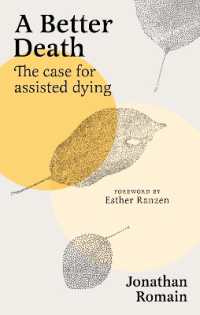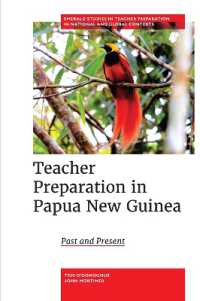- ホーム
- > 洋書
- > 英文書
- > Nature / Ecology
Full Description
This book features four peer-reviewed reviews on improving the welfare of growing and finishing pigs.
The first chapter begins by defining animal welfare in the context of pig production. The chapter discusses pig behaviour and how this can be affected by intensive production systems, group size, living conditions, as well as systems for monitoring animal health and care.
The second chapter explores the relationship between nutrition management and physical and social environments on the welfare of finishing pigs. The chapter also considers the use of environmental enrichment as a means of mitigating aggressive forms of behaviour, such as tail biting.
The third chapter provides a detailed overview of recent research findings on the effects of transport, handling and slaughter practices on the behavioural and physiological responses of pigs. The chapter also reviews how these pre-slaughter practices can impact carcass and meat quality and potentially result in loss of profits.
The final chapter discusses best practices for optimising the general management of growing finishing pigs to improve overall herd health. The chapter considers the impact of substandard herd management and the consequent increased risk of outbreaks of respiratory or digestive diseases, ulcers, lameness, prolapses, tail biting and other conditions.
Contents
Chapter 1 - Optimizing pig welfare in the growing and finishing stage: Arlene Garcia and John J. McGlone, Texas Tech University, USA;
1 Introduction
2 Pig behavioral issues that impact pig welfare
3 Production systems
4 Group size
5 Living conditions in indoor systems
6 Animal health and animal care
7 Conclusion and future trends in research
8 Where to look for further information
9 References
Chapter taken from: Edwards, S. (ed.), Understanding the behaviour and improving the welfare of pigs, Burleigh Dodds Science Publishing, Cambridge, UK, 2021, (ISBN: 978 1 78676 443 0)
Chapter 2 - Welfare of pigs during finishing: Jonathan Amory, Writtle University College, UK; and Nina Wainwright, British Pig Executive (BPEX), UK;
1 Introduction
2 Nutrition management and welfare of finishing pigs
3 Physical and social environment and welfare of finishing pigs
4 Environmental enrichment and tail-biting
5 Practical welfare assessment of finisher pigs
6 Future trends
7 Conclusion
8 Where to look for further information
9 References
Chapter taken from: Wiseman, J. (ed.), Achieving sustainable production of pig meat Volume 3: Animal health and welfare, Burleigh Dodds Science Publishing, Cambridge, UK, 2018, (ISBN: 978 1 78676 096 8)
Chapter 3 - Optimising pig welfare during transport, lairage and slaughter: Luigi Faucitano, Agriculture and Agri-Food Canada, Canada; and Antonio Velarde, Institute of Agrifood Research and Technology, Spain;
1 Introduction
2 Welfare during transport
3 Welfare in lairage
4 Welfare during stunning and slaughter
5 Animal welfare audit protocols
6 Conclusion and future trends
7 Where to look for further information
8 References
Chapter taken from: Edwards, S. (ed.), Understanding the behaviour and improving the welfare of pigs, Burleigh Dodds Science Publishing, Cambridge, UK, 2021, (ISBN: 978 1 78676 443 0)
Chapter 4 - Optimising the health of finisher pigs: Edgar Garcia Manzanilla, Pig Development Department, Teagasc, The Irish Agriculture and Food Development Authority, Ireland;
1 Introduction
2 How to measure pig health in growerfinisher phase
3 Types of farms
4 Animal flow
5 Stocking density
6 The importance of transfer weight and the transition diet
7 General control of infectious diseases
8 Infectious vs. non-infectious diseases
9 Conclusion
10 Where to look for further information
11 References
Chapter taken from: Maes, D. and Segalés, J. (ed.), Optimising pig herd health and production, Burleigh Dodds Science Publishing, Cambridge, UK, 2023, (ISBN: 978 1 78676 883 4)








